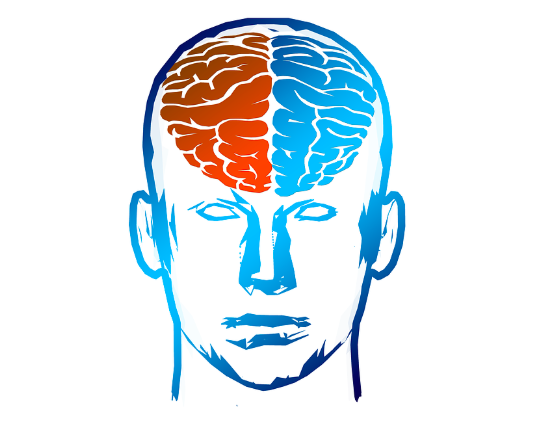Perhaps you have wondered, at one time or another, about your unique characteristics as a person. Maybe you have contemplated the experiences that led you to a favorite hobby or questioned why your greatest challenge is someone else’s strength. Often these self-reflections lead to thoughts of left-brain versus right-brain dominance such as, “I’m bad at math because I’m more of a right brain thinker,” or, “I’m all left brain, with no creativity.” While the brain is a complex organ which contributes to our individualism, the idea of right-brain versus left-brain dominance is actually a myth.
Hemispheric Dominance and The Myth’s Origins
The “neuromyth,” known as hemispheric dominance, is the belief that a more dominant side of the brain results in an individual’s distinct abilities. In this belief, the left side of the brain is associated with characteristics of logic, language, and math while the right side of the brain is responsible for creativity and artistic ability. This myth arose from “split-brain” patient research in the 1960’s which involved the study of patients who suffered from a break in the connection between the brain’s left and right hemispheres. The study revealed that certain brain functions are controlled by particular regions of the brain; functions of language being controlled by the left side and emotion and nonverbal action controlled by the right side.
These findings were true, however, they evolved into beliefs unfounded by the research. Hemispheric dominance became the idea that personality development is influenced by a more developed hemisphere of the brain. In fact, this neuromyth led to the development of programs centered around the concept that understanding a person’s hemispheric dominance can assist the individual in improving management and training practices.
Dispelling the Myth
After the “split-brain” patient research of the 1960s, a study of brain imaging revealed that creative thought stimulated activities across both hemispheres of the brain. This means, that though a function may be associated primarily with one particular hemisphere of the brain, multiple parts of the brain are involved in that activity. Therefore, the idea that particular abilities or brain activities are isolated to a certain hemisphere (left or right) is inaccurate.
Another study by neuroscientists at the University of Utah further dispelled Hemispheric Dominance by scanning the brain activity of individuals undergoing specific tasks. In the study, brain scans were administered to over 1,000 participants. Some participants were asked to lie still during the scan, while others were asked to read. By reviewing the scans and comparing the brain activity, the scientist determined that while there were indications of certain activities being associated with particular regions of the brain, there is no evidence to support the concept that one side of the brain might be more developed than the other.
What Is Really Going On?
With hemispheric dominance debunked, the question remains, “What is really going on?” Why is one person talented in art while another is a math whiz? Further, do these differences have anything to do with hemispherical differences?
The answers may lie in understanding hemispheric differentiation which explains that the brain, while divided into left and right hemispheres, also consists of a list of different areas. The areas pertinent to function are the frontal lobe (executive functions and thinking), motor cortex (movement), sensory cortex (sensations), parietal lobe (perception), occipital lobe (vision), temporal lobe (memory and language), and the medulla oblongata (breath, heart, and respiration). These areas of the brain, while specialized for particular cognitive functioning, work together to carry out tasks through a network of neurons. It is these connections, throughout all areas of the brain, that allow for creative and analytical thought.
While hemispheric differentiation and the impact on cognitive functioning are not fully understood. One theory suggests that a person’s neural network design affects cognitive ability. How well a particular region of the brain functions or how involved it becomes in certain activities may be a result of how frequently it was previously stimulated and how the network of nerves developed. Connections between brain areas can create dynamic patterns of functioning which differ from one individual to the next. Therefore, differences in abilities, such as in math or in art, have more to do with the connections throughout the brain rather than how one hemisphere functions compared to the other.
References
Corballis, M. C. (n.d.). Left Brain, Right Brain: Facts and Fantasies. Retrieved May 29, 2018, from http://journals.plos.org/plosbiology/article?id=10.1371/journal.pbio.1001767
Debunking the Left-Brain/Right-Brain Myth |. (n.d.). Retrieved May 28, 2018, from http://scienceoflearning.jhu.edu/science-to-practice/resources/debunking-the-myth-about-left-brain-right-brain-learning-styles
Left Brain/Right Brain Mythology and Implications for Management and Training. (n.d.). Retrieved May 29, 2018, from https://journals.aom.org/doi/abs/10.5465/amr.1987.4306708
Lombrozo, T. (2013, December 02). The Truth About The Left Brain / Right Brain Relationship. Retrieved from https://www.npr.org/sections/13.7/2013/12/02/248089436/the-truth-about-the-left-brain-right-brain-relationship
How your brain works. (2016, April 20). Retrieved from https://www.mayoclinic.org/brain/sls-20077047?s=4






